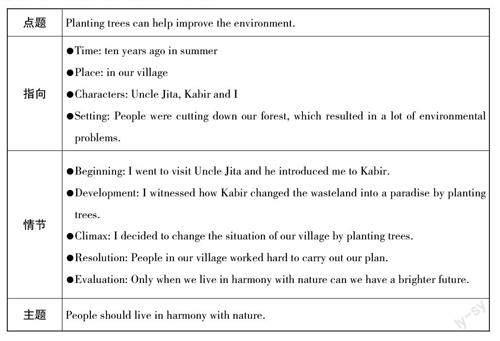合理运用衔接,建构连贯续文
2024-03-13王思
王思

【问题导读】
读后续写要求考生在语言输出的过程中做到“模仿语言,创造内容”,利用前文提供的语境,伴随语篇情境,在确保内容合乎逻辑的前提下续写下文。一篇好的续写文章,不仅需要丰富的内容、巧妙的构思和形象的表达,还需要把这些内容联系起来的语篇衔接手段。衔接是一种能使上下文之间取得连接与过渡的写作技法,能使文章保持意义的连贯、文句的流畅和行文的变化。
【名师导学】
读后续写的评分标准主要涵盖内容、语言表达和篇章结构三方面,其中篇章结构主要包括上下文的衔接和全文的连贯性。《普通高中英语课程标准(2017 年版2020年修订)》要求学生能“根据交流的需要选择恰当的语篇类型、设计合理的语篇结构、规划语篇的组成部分、保持语篇的衔接性和连贯性”。衔接是将篇章中的句子连接成一个整体,从而创造连贯的重要手段。读后续写中的衔接主要通过语法和词汇手段来实现,具体为照应、替代、省略、连接词和词汇衔接。
1.照应指用代词等语法手段来表示语义关系,即在语篇中某个名词或概念第二次或重复出现时应使用恰当的代词或其他成分来替代。英语中的照应主要分为三类:人称照应、指示照应、比较照应。
2.替代指用其他词代替上文提及的内容,这样可以避免重复,达到语言凝练、语句连贯的目的。替代包括名词性替代(如one、ones、some 等)、动词性替代(如do、does、did、doing、done等)和从句性替代(如so、not 等)。
3.省略的作用同替代相似。省略可以使上下语义联系紧密,强调作者要表达的中心思想。省略大致分为三类:名词性省略、动词性省略、分句性省略。
4.连接词指能把两个或多个短句衔接起来的表达一定逻辑关系的词。根据它们表示的关系可以分为四大类:增补(如and、also、too、furthermore等)、转折或对比(如but、yet、still、nevertheless、though、while、however等)、原因或结果(如because、for、as、since等)和时间(如first、second、third等)。
5.词汇衔接指在衔接纽带的一端出现一个项目后,另一端被相同或相近意义的词汇所占据。词汇衔接手段是作者通过词汇的选择与复现得以实现的,选择是前提,复现是手段。词汇复现手段较易理解,指在语篇中词与词之间存在的原词重复、同(近)义词复现、反义词复现、上下义词复现、整体与部分关系和搭配关系。
【案例导引】
阅读下面短文,根据所给情节进行续写,使之构成一个完整的故事。
I met the Man of the Trees in summer ten years ago, when I was visiting Uncle Jita.
Those were difficult times. People were cutting down our forest, and there was oftenflooding. Sometimes our water supply was dirty. When our pump (泵) did have cleanwater, we had to wait in line for ages. When the pump wasn't working, we had to walk fivekilometres to the closest stream.
But I was happy. I was going to see my favorite uncle. When the day finally arrived,Dad drove me to Uncle Jita's house and left. Once he saw me, Uncle Jita announced,“ To?morrow we're going to explore a magical place. Here is my camera, Amy. You can take pho?tos of what you see.”
The following day, we woke up and left early on a boat. The trip was exciting. Butwhen we got off, there was nothing in front of us.“ I don't want to take pictures of this,” Icomplained.
Uncle laughed,“ Start walking, Amy. I promise you'll be surprised.” After some time, Icould see the outline of a forest in the distance. A little closer, there was a man waving tous.
“That's Kabir. The forest you see is his. He planted every single tree.” As we walkedtowards Kabir, Uncle explained that thirty years ago, the whole area was a wasteland. Butone day, Kabir decided to change all that and started planting trees. Thanks to him, part ofthe wasteland is now a paradise.
Uncle introduced me to Kabir, who had gray hair and a determined face.“ Jita told meyou like animals. Are you ready to see some?” he asked.“ Of course!” I replied. We conti?nued walking and soon were under the trees. I turned my head and was amazed at the differ?ence between the two places. All because of the efforts of one man.
Like Uncle said, Kabir's forest was magical. We saw deer, rhinos, and even tigers.During lunchtime, Kabir explained how, by planting trees, it was possible to stop the land from eroding( 侵蚀).
注意:续写词数应为150左右。
Paragraph 1:
Hearing this, I turned to Uncle,“ I think we can plant trees too.”________________
Paragraph 2:
In the years that followed, people in our village worked hard to carry out our plan._________________
一、故事梳理
本文讲述的是艾米于十年前的夏天到吉塔叔叔家度假时遇到了“种树之人”的故事。那时,艾米所在的村庄环境堪忧,树木遭到砍伐,净水资源严重不足,村民用水非常不便,但艾米却处在马上要见到自己最喜欢的叔叔的兴奋之中。艾米到叔叔家的第二天,叔叔带她参观了卡比尔花费三十年时间亲手种植的神奇森林。目睹卡比尔凭一人之力创造的“天堂”,听他讲述种树如何防止水土流失,艾米马上想到自己所在的村庄也可以通过种树来改善环境。
二、常用衔接方法的应用
(一)照应
1. 人称照应:通过人称代词(如I、you、he、she、they、him、her、them等)、所属限定词(如your、his、her、their等)和所属代词(如mine、his、hers、theirs等)来实现。
续写第一段,当我们拿着照片去劝说村民种树时,他们被森林的美所震惊。“When Uncle and I went back to the village several days later and showed these wonderfulpictures to my neighbours, they were stunned by the beauty of the forest.”。这里,我们用人称代词they来指代前面提到的my neighbours。
2. 指示照应:用于指示照应的词也可以分为名词性指示词this、that、these、those,定冠词the,副词性指示词now、then这三类。
续写第二段,通过全村人的共同努力,村里的环境发生了巨大的变化。多亏了村民种的树,村里的水质变好了,水的供给也稳定了。“Thanks to the trees, the water hasbeen purified and we finally have a clean and stable water supply.”。因trees和water都在前面提到过,所以这里用了定冠词the。
3. 比较照应:使用一些有比较意义的形容词或副词的比较级表达连贯的语义(如same、as、so、equal、such、similarly、differently、other、otherwise、likewise等)。
续写第二段,经过村民们多年的努力,村里的环境发生了很大的改变。我们在续写的时候可以利用比较、照应的手法来进行衔接,对比种树前后村里的环境变化。“With our joint efforts, our village now looks different, which is surrounded by small thri?ving forests with blooming flowers, lively animals and crystal?clear streams runningthrough.”。跟种树前缺水、水脏的情况相反,现在村里有茂密的森林、盛开的鲜花、活泼的动物和清澈的河流,这些东西也正好照应了前文对卡比尔所种植的森林的描述。
(二)替代
根据续写第二段的首句,我们可以反推出续写第一段的结尾:我们成功说服了村民实施我们的种树计划。“We then persuaded the villagers to carry out our tree?plantingplan, and they agreed to do so.”。这里,我们用so 来替代前面的carry out our tree?planting plan,避免了重复。
(三)省略
根据续写第二段的首句,我们知道村民们开始种树,这跟原文第二段描述的People were cutting down our forest 相照应。“Instead of cutting down the trees, we started to plant, which has eventually helped protect the soil and stopped the land from eroding.”。“我们”不再砍树,“我们”开始种(树)。这里为了避免重复,我们省略了plant后面的the trees。
(四)连接词
结合故事情节的发展,种树给村里带来了很多积极的影响。我们在续写时需要对这些积极的影响进行详细的描述,以突出种树的重要性。“Instead of cutting downour forest, we started to plant trees, which has eventually helped protect the soil andstopped the land from eroding. Thanks to the trees, the water has also been purified and wefinally have a clean and stable water supply.”。这里用了and和also来体现种树所带来的一系列的好处,凸显了人与自然应该和平共处的主题。
(五)词汇衔接
续写第一段,为了说服村民们一起种树,“我”决定拍照给村民看。“‘I've got aplan! I'll show them the photos of Kabir's magical forest! ... When Uncle and I went backto the village several days later and showed these wonderful pictures to my neighbours,they were stunned by the beauty of the forest.”。这里,photos 和pictures 属于同义词复现,这样既避免了单词的重复,又能使句子之间的联系更紧密。同样,续写第二段,“Instead of cutting down our forest, we started to plant trees, which has eventually helpedprotect the soil and stopped the land from eroding.”。这个句子中的forest 和trees 也属于此类衔接手法。
参考范文
Paragraph 1:
Hearing this, I turned to Uncle,“ I think we can plant trees too.” Grabbing the camerain my hand, I added with excitement.“ I've got a plan! I'll show the villagers the photos ofKabir's magical forest!” Seeing Uncle and Kabir's encouraging smile, I immediately setdown to my work, busily pressing my shutter and capturing the amazing scenes in the for?est. When Uncle and I went back to the village several days later and showed these wonder?ful pictures to my neighbours, they were stunned by the beauty of the forest.“ It was thetrees that turned the place into a paradise!” We then persuaded the villagers to carry outour tree?planting plan, and they agreed to do so.
Paragraph 2:
In the years that followed, people in our village worked hard to carry out our plan. In?stead of cutting down our forest, we started to plant trees, which has eventually helped pro?tect the soil and stopped the land from eroding. Thanks to the trees, the water has also beenpurified and we finally have a clean and stable water supply. With our joint efforts, our vil?lage now looks different, which is surrounded by small thriving forests with blooming flow?ers, lively animals and crystal?clear streams running through. Witnessing the gradualchange of our village, we came to realize that only when we live in harmony with nature canwe have a brighter future.
【模拟导练】
阅读下面材料,根据其内容和所给段落开头语续写两段,使之构成一篇完整的短文。
It was lunch hour. Escaping from my office, I fled down Main Street in pursuit of free?dom from the routine of the day. An old bell clanged (叮当作响) against the door of a dustyused bookstore when I pushed it open.
Looking through the horizon of shelves and lots of magazines, my eyes suddenly methis and my heart began to race. They were the blazing (闪烁) orange eyes of an African lionon the cover of a magazine. I hadn't seen those eyes in the past thirty years, but their im?pact on me hadn't faded. As a kid, I used to dream about Africa, living with wild animals.
The opportunity of spending a“ gap year” volunteering in Africa or joining the YouthCorps had long since passed. It was true that I couldn't go to Africa for several months, butmaybe I could volunteer in Africa for a few weeks.
Over the next several weeks, I began to budget and save, determined to make it hap?pen. The big day came. I arrived and met my boss, a young South African ranger (护林员)named Gary. He said,“ Let me guess, you're here because you dreamed of Africa.”
“Yes!” I smiled.
“Well, it's time to wake up. This is a working game reserve. These are wild animals.”
“Okay.”
“You're going to have to get out of your comfort zone and take some risks. You needthe courage of a lion.”
The next morning when we began our patrol (巡邏) in an open?air jeep, giant Africanelephants appeared in the morning mist. I was no longer dreaming in the pages of the maga?zine. I was living them.
Moments later, Gary parked the jeep and handed me a heavy shovel (铲) and said,“Time to shovel dung (粪).” Elephant dung. Mountains of it! It will be used as fertilizer inthe reserves sustainable vegetable garden.
Within fifteen minutes, my back was aching, and my new work gloves were stretchedout and they were so slippery with dung and sweat that they refused to stay on my hands.This wasnt my dream of Africa.
注意:续写词数应为150左右。
Paragraph 1:
I began to question myself. ________________
Paragraph 2:
But at that moment I remembered Gary's words“ step out of your comfort zone”______________
【评价导思】
1. 你在续写的时候是否运用了衔接手段?使用了哪些衔接手段?
2. 除了前面提到的衔接手段,你还可以使用哪些衔接手段来使文章内部的连贯程度得到提升?
3. 在平时的写作训练中,你应该如何合理运用衔接手段,培养语篇连贯意识,提高续文的质量?
